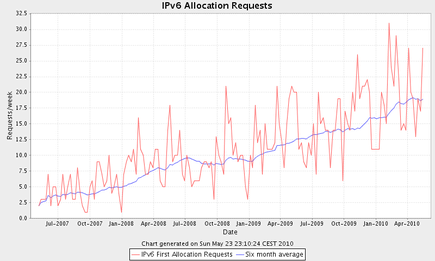It’s Time To Talk About IPv6

The theme of this year’s Oracle OpenWorld (apart from a rousing victory against New Zealand) was Big Data and the Internet of Things. Splashed across every billboard and demo on the Moscone floor, we saw the impact of an ever-expanding amount of information traveling through desktops, smartphones, appliances and people. It’s an exciting landscape for many technology industries, but especially for networking. For A10, it’s the right time to re-enter a discussion on IPv6 migration. Not long ago, Motorola claimed that the future of information transmission would be adding connectivity to physical objects. Radio frequency identification (RFID) tags, for example, are being placed in parts and products to enable these objects with intelligence and capability.
RFID tags, among other developments in the Internet of Things, will add significantly to the scale of new Internet nodes. It is a given that the as-good-as exhausted numbers of IPv4 addresses will not be able to support this amount of connectivity. IPv6, therefore, is a key facilitator of the Internet of Things. It gives an enormous address book to enable the connectivity of smart appliances, mobile devices, and more. In a blog by Akamai, we can see that the need for IPv6 is driven by three factors of Internet expansion:
- Content availability
- Availability of IPv6 from access network providers
- End-user device support
Because IPv6 is not backwards compatible, networks will have to set in place transition mechanisms between IPv4 and IPv6. Enterprises will be forced to switch to IPv6 alongside their current IPv4 services to accompany these drivers of IPv6 growth.

A graph of IPv6 Allocation Requests from 2007-2010. In this graph by RIPE Network Coordination Centre, we see that from the time IPv6 was first offered by RIPE NCC, the demand for IPv6 is steadily growing. Source: RIPE NCC
This can be seen as an overwhelming task for IT, and indeed making an entire transition to IPv6 will take time. But the process can begin at picking the right ADC. From its roots, A10 was an early leader in the topic of IPv6 migration and CGN technology. Starting from 2007, we have released tools to enable IPv6 migration in our ADCs. Our Thunder and AX Series devices can connect a network to the IPv6 realm and allow IPv4 to coexist with IPv6 and therefore ease the complexity of migration. This means architects can use different functions within their ADC to facilitate IPv6 connectivity. Some of our ADCs features are:
- Server Load Balancing Protocol Translation (SLB-PT): to connect IPv4-only servers to the IPv6 Internet
- Carrier Grade NAT (CGN): to preserve public IPv4 address allocations
- 6rd: to enable IPv6 access over an existing IPv4 core
- NAT64/DS64: to enable IPv6-only clients to connect to IPv4 resources
- DS-Lite: to allow IPv4 access over IPv6 core
CGN is a key capability in this solution set. It can be thought of as a standardized NAT behavior. Unlike the proprietary NAT implementations often seen on firewalls, it provides transparency for end-user applications, establishing traits like IP address ‘stickiness’ to make sure the same IP address is used for a translated client IP. CGN ensures customers can maintain their IPv4 connectivity in the most transparent way, while IPv6 migration technologies can be phased in without rushing. At A10, we understand the need to facilitate a bigger Internet, hassle-free. You can read more about our IPv6 migration capabilities here and find out if the A10 solution is right for you.
Seeing is believing.
Schedule a live demo today.